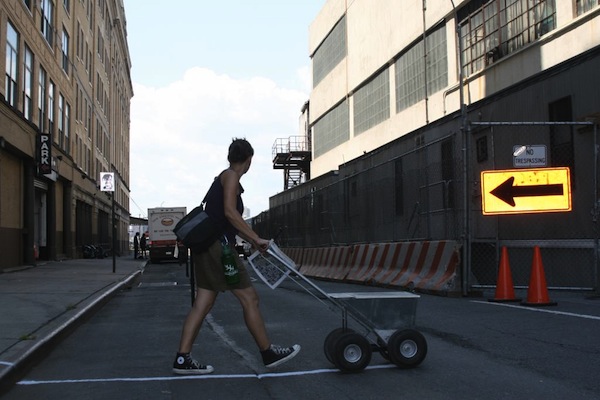101 Female Artists
It’s a well-known fact that women are under-represented in most histories of art, especially before the 1960s. When we look at even modernist art movements, it’s rare to see women really talked about in books or represented in museum collections. When we think about surrealism, for example, one of the most iconic works of the movement is Meret Oppenheim’s “Object”, a teacup and saucer covered in fur – but when we read about surrealists, it’s usually about Dali & Magritte, or some other man.
It gets worse when we go pre-modernist as the areas of art that women traditionally worked within are undervalued; friezes, frescoes, and sculptures we hear about – but embroidery & weaving? Not so much.
In 1985 Guerilla Girls formed to showcase the undervaluing of women in the arts.
Guerrilla Girls were formed by 7 women artists in the spring of 1985 in response to the Museum of Modern Art’s exhibition “An International Survey of Recent Painting and Sculpture”, which opened in 1984. The exhibition was the inaugural show in the MoMA’s newly renovated and expanded building, and was planned to be a survey of the most important contemporary artists.
In total, the show featured works by 169 artists, of whom only 13 were female.
wikipedia
Now, I know I’m hammering on the same nail here, but the point of the Guerilla Girls bears repeating…
According to (the Guerilla Girls), male artists and the male viewpoint continued to dominate the visual art world. In a 1989 poster (displayed on NYC buses) titled “Do women have to be naked to get into the Met. Museum?” they reported that less than 5% of the artists in the Modern Art sections of the Met. Museum were women, but 85% of the nudes were female.
Over 20 years later, women were still under-represented in the art world. In 2007, Jerry Saltz (journalist from the New York Times) criticized the Museum of Modern Art for undervaluing work by female artists. Of the 400 works of art he counted in the Museum of Modern Art, only 14 were by women (3.5%). Saltz also found a significant under-representation of female artists in the six other art institutions he studied.
wikipedia
The dearth of women being represented in the arts doesn’t end with art history texts and museums, though, it’s also evident in progressive metatexts like wikipedia. Why aren’t female artists as well represented as male artists? Well, not to make to fine a point, but quite simply nobody has been submitting female artists to the collective knowledge base.
Enter the Art+Feminism Wikipedia Edit-a-Thon.
Last Saturday, about 600 volunteers in 31 venues around the globe engaged in a collective effort to change the world, one Wikipedia entry at a time.
In the United States, Canada, Australia, Italy, the Netherlands, and the United Kingdom, in nonprofits and art schools, in museums and universities, these people—mostly women—set out to write entries, uncredited and unpaid, for the fast-growing crowd-sourced online encyclopedia.
They had answered a call for the Art+Feminism Wikipedia Edit-a-Thon, a massive multinational effort to correct apersistent bias in Wikipedia, which is disproportionally written by and about men.
One of the things I like best about the internet is how it enables diverse groups of people to interact with one another meaningfully in knowledge-sharing and in creating stronger networks . This kind of effort is exactly the sort of thing that puts the lie to early pooh-poohers of the internet that said nobody would contribute their knowledge for free… People not only do contribute to the internet for free, but revel in it.
As an opportunity for feminist history, the internet is unequalled – it is egalitarian in that the only information that exists is the information entered into it. When it hits a network with wide dispersal like Wikipedia, the only limitation is the involvement of the public.
101 Women Artists Who Got Wikipedia Pages This Week
There is some very cool work in here that I have to admit I was not aware of before; it is absolutely worth checking out.
My personal fave from the project is Eve Mosher:
Eve Mosher is an American environmental artist living and working in New York City. She is best known for her public art installation HighWaterLine, which premiered in New York City in 2007. Her predictions about where waters would rise due to climate change were validated by flood levels during Hurricane Sandy in 2012…. Eve Mosher used topographic maps, satellite images, and data from NASA’s Goddard Institute for Space Studies at Columbia University, to predict the locations likely to be subject to flooding. Then Mosher walked 70 miles of New York coastline to draw a 4″ blue chalk line on the ground, marking the predicted water levels.
I like this piece in particular in that it turned out to be prophetic – when Hurricane Irene hit New York it flooded to pretty much where Mosher predicted, destroying many of the Chelsea galleries.
In any case, check out the project. You will find an inspiring artist you have never heard of, in all probability.
And now that you’re inspired, add to the profile of a woman artist on Wikipedia, or start a new one. I can think of a couple of existing profiles I’d love to flesh out offhand, Genevieve Cadieux, Jana Sterbak, Betty Goodwin, and Irene Whittome – for a start.


![[no title] 1985-90 by Guerrilla Girls null](http://greynotgrey.com/blog/wp-content/uploads/2014/02/Guerilla-Girls.jpg)






